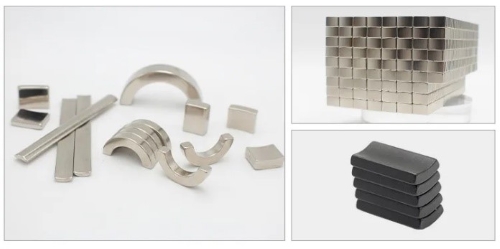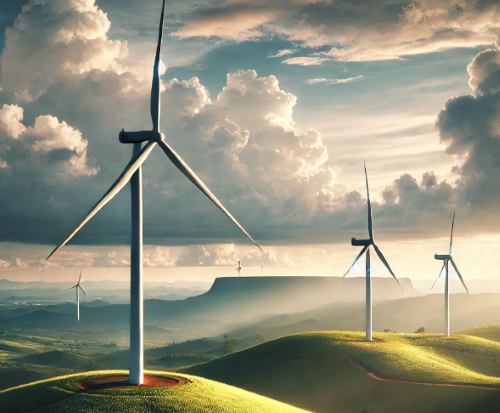
Introduction
Permanent magnets, especially those made from rare-earth elements like neodymium-iron-boron (NdFeB), play a pivotal role in modern wind turbine technology. These magnets are essential in converting wind energy into electricity, helping to power homes, businesses, and even entire cities with renewable energy.
Let’s discover how permanent magnets in wind turbines function and offer benefits.
What Are Permanent Magnets?
Permanent magnets are materials that maintain a magnetic field without needing an external power source. Unlike electromagnets, which rely on electric currents to create a magnetic field, permanent magnets are made from specific materials that exhibit strong and stable magnetism. Neodymium-iron-boron (NdFeB) and samarium-cobalt (SmCo) are two types of rare-earth permanent magnets commonly used in high-performance applications due to their exceptional magnetic strength.

Permanent Magnets in Wind Turbines
Wind turbines rely on the principles of electromagnetic induction to convert the kinetic energy of wind into electrical energy. Permanent magnets in turbines generate the magnetic field required for this process, enabling efficient and reliable energy production. Their use is particularly critical in direct-drive wind turbines, which are becoming more popular due to their efficiency and lower maintenance needs.

Here’s how permanent magnets power wind turbines:
- Magnetic Field Generation: Permanent magnets create a strong magnetic field that interacts with the moving components of the wind turbine, specifically the stator and rotor, to generate electricity. This magnetic field is key to transforming the rotational motion of the turbine blades into electrical energy.
- Direct-Drive Systems: In traditional wind turbines, gearboxes are used to increase the speed of rotation from the blades before transferring energy to the generator. However, gearboxes can wear down, leading to higher maintenance costs and more frequent repairs. Permanent magnets allow for direct-drive wind turbines by creating a stable magnetic field that generates electricity without needing a gearbox. The direct-drive setup reduces mechanical complexity and enhances reliability, making it ideal for both onshore and offshore installations.
- Compact and Lightweight Design: Permanent magnets, particularly neodymium-based ones, have a high magnetic strength relative to their size. This allows wind turbines to be more compact and lightweight, maximizing energy output without needing larger and more complex machinery. This is especially beneficial in offshore wind farms, where the weight of the turbine structure impacts both construction and maintenance.
Advantages of Permanent Magnets in Wind Turbines
The use of permanent magnets in wind turbines offers multiple advantages, which contribute to both the efficiency and longevity of wind energy systems:
- High Efficiency: Permanent magnets maintain a consistent magnetic field, allowing for efficient energy conversion. With fewer moving parts in direct-drive systems, energy loss due to friction and wear is minimized, increasing overall efficiency.
- Enhanced Reliability: Fewer mechanical parts mean less maintenance, especially compared to traditional turbines with gearboxes. This is particularly valuable in offshore wind farms, where access for repairs is challenging and costly.
- Higher Power Density: The magnetic strength of neodymium magnets allows turbines to produce more power in a smaller footprint, making it possible to generate high levels of electricity without requiring massive structures.
- Noise Reduction: Direct-drive wind turbines with permanent magnets operate more quietly, making them suitable for onshore applications near residential areas or environmentally sensitive zones.
Applications of Permanent Magnets in Wind Turbines
Permanent magnets are embedded into various parts of wind turbines to optimize functionality and enhance energy production. Here are a few common applications:
- Generators: The main use of permanent magnets in wind turbines is in the generator, where they produce the magnetic field necessary for electricity generation. Permanent magnet synchronous generators (PMSGs) are particularly popular, as they are efficient, durable, and can produce high power outputs.
- Pitch and Yaw Control Systems: Permanent magnets are also used in the control systems of wind turbines, specifically in pitch and yaw control mechanisms. The pitch control system adjusts the angle of the blades, optimizing their position to capture wind efficiently. Meanwhile, the yaw control system rotates the entire turbine to align with the wind direction. Magnets help provide precise and reliable control, ensuring the turbine operates optimally in changing wind conditions.
- Magnetic Bearings: In some wind turbine designs, magnetic bearings replace traditional mechanical bearings. By supporting loads with magnetic fields, magnetic bearings reduce friction and wear, enhancing turbine lifespan and efficiency. This frictionless support system also reduces the need for lubrication, which further lowers maintenance needs.
Conclusion
Permanent magnets are essential to the efficiency and reliability of modern wind turbines, helping convert wind energy into electricity with minimal mechanical wear and high efficiency. As the renewable energy sector grows, permanent magnets, particularly neodymium-based magnets, will continue to be at the heart of wind energy advancements, allowing for powerful, compact, and sustainable energy generation. For more magnet products and magnet assemblies, please visit Stanford Magnets.
